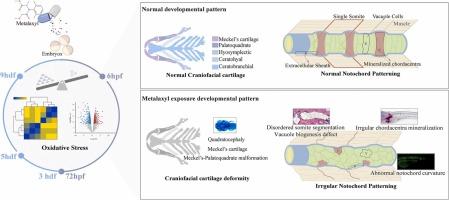基于生化和转录组学的甲乙基诱导斑马鱼脊索毒性研究
IF 11.3
1区 环境科学与生态学
Q1 ENGINEERING, ENVIRONMENTAL
引用次数: 0
摘要
甲螨灵是一种应用广泛的酰基苯胺类系统杀菌剂,可通过淋滤和土壤径流进入生态系统。本研究以斑马鱼为模型生物,通过转录组学、药理干预和分子生物学检测等手段,深入研究环境相关的甲氨甲酯水平对斑马鱼胚胎脊索发育的有害影响,并阐明其潜在的分子机制。初步结果表明甲氨甲酯对斑马鱼胚胎发育参数有显著的影响。本研究还评估了斑马鱼胚胎发育期间甲螨灵暴露的长期后果。该研究表明,暴露于甲轴酯的斑马鱼表现出一系列异常,包括脊索液泡生物发生缺陷、体块分割障碍、脊索异常弯曲、颅面软骨畸形和不规则脊索中心矿化。通过转录组学和生物信息学分析发现,大多数表现出差异表达的基因与氧化应激有关。此外,有证据表明存在氧化应激,如丙二醛(MDA)产生增加和抗氧化酶活性(CAT, SOD, GSH)降低所证明的那样。有趣的是,绿原酸可以部分修复甲氨酯诱导的发育障碍。总的来说,甲轴酯通过调节活性氧介导的氧化应激,破坏斑马鱼胚胎脊索和骨骼的形成。本文章由计算机程序翻译,如有差异,请以英文原文为准。

Characterization of Metalaxyl-induced notochord toxicity based on biochemical and transcriptomics in zebrafish (Danio rerio) model
Metalaxyl is an acylanilide systemic fungicide that is widely applied and can readily enter ecosystems through leaching and soil runoff. This research utilized zebrafish as a model organism to thoroughly investigate the detrimental impacts of environmentally relevant levels of metalaxyl on the development of the notochord in zebrafish embryos and to elucidate the underlying molecular mechanisms through transcriptomics, pharmacological intervention and molecular biological detection. The preliminary results demonstrated that metalaxyl induced significant modifications in the developmental parameters of zebrafish embryos. This study has also assessed the long-term consequences of metalaxyl exposure during the embryonic development of zebrafish. This study have demonstrated that zebrafish exposed to metalaxyl exhibit a range of abnormalities, including defects in notochord vacuole biogenesis, somite segmentation disorders, anomalous notochord curvatures, craniofacial cartilage deformities, and irregular chordacentra mineralisation. Through transcriptomic and bioinformatics analysis, it was found that most of the genes exhibiting differential expression were linked to oxidative stress. Furthermore, the evidence indicated that oxidative stress was present, as demonstrated by increased malondialdehyde (MDA) production and a decrease in antioxidant enzyme activity (CAT, SOD, GSH). Interestingly, the developmental dysfunction induced by metalaxyl was partially rescued by chlorogenic acid. Overall, metalaxyl disrupts notochord and skeletal formation in zebrafish embryos by modulating oxidative stress mediated by reactive oxygen species.
求助全文
通过发布文献求助,成功后即可免费获取论文全文。
去求助
来源期刊

Journal of Hazardous Materials
工程技术-工程:环境
CiteScore
25.40
自引率
5.90%
发文量
3059
审稿时长
58 days
期刊介绍:
The Journal of Hazardous Materials serves as a global platform for promoting cutting-edge research in the field of Environmental Science and Engineering. Our publication features a wide range of articles, including full-length research papers, review articles, and perspectives, with the aim of enhancing our understanding of the dangers and risks associated with various materials concerning public health and the environment. It is important to note that the term "environmental contaminants" refers specifically to substances that pose hazardous effects through contamination, while excluding those that do not have such impacts on the environment or human health. Moreover, we emphasize the distinction between wastes and hazardous materials in order to provide further clarity on the scope of the journal. We have a keen interest in exploring specific compounds and microbial agents that have adverse effects on the environment.
 求助内容:
求助内容: 应助结果提醒方式:
应助结果提醒方式:


